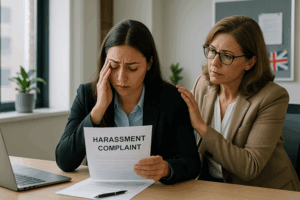What is workplace harassment in the UK? Definition, law & examples?

You shouldn’t have to dread going to work. If colleagues are making offensive jokes about your race, your boss is pressuring you for sexual favours, or you’re being systematically excluded and humiliated, you’re likely experiencing workplace harassment, and it’s unlawful under workplace harassment UK legislation. Given the complexity of employment tribunals and strict legal deadlines, seeking advice from a specialist employment law solicitor early can make the difference between justice and continued suffering.

Key Takeaway: Can my employer be liable if unaware of the harassment?
Workplace harassment victims have powerful legal rights. Learn how to use them to secure justice and compensation.
UK workplace harassment law: Legal definition and framework
Workplace harassment has a precise legal definition under Section 26 of the Equality Act 2010: “unwanted conduct related to a relevant protected characteristic, and which violates a person’s dignity or has the purpose or effect of creating an intimidating, hostile, degrading, humiliating or offensive environment”.
This statutory definition sets out specific criteria that determine when behaviour crosses the line from workplace conflict into unlawful harassment:
- The conduct must be unwanted and related to protected characteristics like race, sex, disability, age, religion, or sexual orientation.
- The behaviour must violate your dignity or create a hostile work environment for you or others.
- The conduct must be intimidating, degrading, humiliating or offensive to a reasonable person.
- Impact matters more than intent. Claiming you were “just joking” provides no legal defence.
- Protection extends to harassment by colleagues, managers, customers and third parties.
- Multiple laws protect you: Equality Act 2010, Employment Rights Act 1996, and Protection from Harassment Act 1997.
Whether a reasonable person would consider workplace harassment to have occurred is the legal test, not just your feelings about the situation.
What is considered workplace harassment?
Workplace harassment manifests in various forms, each carrying distinct legal implications and remedies. Understanding these types of workplace harassment helps you identify unlawful behaviour and take appropriate action.
Protected characteristics harassment
This occurs when unwanted conduct relates to your race, sex, disability, age, religion, sexual orientation, gender reassignment, pregnancy or marriage status. The harassment doesn’t need to be explicitly about these characteristics; indirect references or assumptions suffice.
Protected characteristics harassment includes racial slurs, religious mockery, age-related comments, or deliberate misgendering that creates a degrading work environment:
- Making jokes about someone’s accent or cultural practices.
- Using outdated pronouns deliberately after being corrected.
- Commenting on someone’s religious dress or dietary requirements.
- Colleagues repeatedly mispronouncing your foreign name despite corrections.
- Excluding older employees from training opportunities while citing “tech-savviness”.
Sexual harassment in the workplace
Sexual harassment requires no connection to protected characteristics; any unwanted conduct of a sexual nature qualifies. Since October 2024, employers have a legal duty to prevent this behaviour proactively.
Sexual harassment covers unwanted touching, sexual comments, inappropriate images, persistent romantic advances, or creating a sexually charged workplace atmosphere:
- Persistent requests for dates after rejection.
- Sexual comments about appearance, clothing, or body parts.
- Unwanted physical contact, touching, or invasion of personal space.
- Sharing inappropriate images, jokes, or videos via email or messaging.
- Creating a sexually charged atmosphere through displays or conversations.
General harassment and intimidation
Under the Protection from Harassment Act 1997, behaviour causing alarm or distress constitutes harassment even without protected characteristic links. This includes persistent, unwanted conduct that affects your wellbeing.
General harassment and intimidation encompasses persistent criticism, deliberate exclusion, spreading malicious rumours, aggressive behaviour, or cyberbullying that causes distress:
- Cyberbullying through work systems or social media.
- Deliberate exclusion from meetings, emails, or social activities.
- Spreading malicious rumours or gossip about your personal life.
- Constant criticism or undermining of your work without justification.
- Aggressive or threatening behaviour, shouting, or intimidation tactics.
Workplace harassment vs bullying: The legal distinction
Workplace harassment vs bullying creates confusion for many employees, yet the difference between bullying and harassment at work determines your legal rights and available remedies:
- Harassment must relate to protected characteristics (race, sex, disability, age, religion, sexual orientation) or be sexual in nature.
- Bullying can occur for any reason, including personality conflicts, work performance disputes, or personal animosity.
- Harassment provides automatic legal protection and tribunal remedies under equality legislation.
- Bullying may only be actionable if it breaches employment contracts or health and safety duties.
- Harassment has a lower threshold. Even single incidents can constitute unlawful conduct.
- Bullying typically requires a pattern of behaviour over time to establish breach of duty.
Workplace harassment examples: A manager constantly shouting at a female employee about her “emotional” decision-making constitutes workplace harassment (sex discrimination), while shouting at all employees equally may only amount to workplace bullying without specific legal remedy.
Workplace harassment: Employer duties and vicarious liability
Your employer cannot simply claim ignorance when workplace harassment occurs. They have specific legal duties and can be held liable for their employees’ actions. Since October 2024, employers must proactively prevent sexual harassment, marking a significant shift from reactive to preventative responsibility.
Key employer obligations that protect you:
- Prevent harassment: Take reasonable steps to stop harassment before it occurs.
- Investigate complaints: Respond promptly and thoroughly to any harassment allegations you raise.
- Take corrective action: Implement disciplinary measures against perpetrators and prevent recurrence.
- Provide safe workplace: Maintain an environment free from intimidation and discrimination.
- Train staff: Ensure employees understand what constitutes harassment and reporting procedures.
- Review policies: Regularly update harassment policies and communicate them clearly to all staff.
Vicarious liability means you can sue your employer even when they didn’t personally harass you; them being legally responsible for their employees’ actions during work time. This includes harassment by colleagues, managers, and even third parties like customers when employers fail to take reasonable protective steps.
Workplace harassment: Employee rights and legal remedies
Workplace harassment victims possess powerful legal rights that can deliver both justice and compensation. Your fundamental rights extend beyond simply reporting incidents – you’re entitled to a harassment-free workplace and legal remedies when this standard is breached.
The law provides multiple pathways to hold perpetrators and employers accountable:
- Employment tribunal claims: Seek compensation for injury to feelings, financial losses, and future earnings.
- Constructive dismissal: Resign and claim unfair dismissal if harassment makes your position untenable.
- Personal injury claims: Pursue damages for psychological harm, stress, and mental health impacts.
- Criminal prosecution: Report serious harassment as criminal offences under the Protection from Harassment Act 1997.
- Interim relief: Obtain emergency tribunal orders to stop ongoing harassment while your case proceeds.
- Reinstatement orders: Force employers to give you your job back if harassment led to dismissal.
Compensation typically ranges from £1,000 to £50,000 for injury to feelings, with no upper limit for financial losses like lost earnings, medical expenses, or career damage. Aggravated damages apply when employers handle complaints particularly badly or show discrimination in their response.
You’re also protected from victimisation. Any negative treatment because you’ve complained about harassment or supported someone else’s complaint is itself unlawful and attracts additional compensation.
Do I need a workplace harassment solicitor?
Whether you’re experiencing workplace harassment or facing allegations yourself, specialist legal advice is essential for protecting your interests and achieving the best possible outcome. The complexity of employment law and strict procedural requirements make professional representation crucial rather than optional:
- Employment tribunal claims must be filed within three months minus one day, and missing this deadline destroys your case entirely.
- Workplace harassment solicitors know exactly what evidence strengthens harassment claims and how to present it persuasively to tribunals.
- Experienced lawyers calculate the full extent of your losses, often securing significantly higher compensation than self-represented claimants.
- Employment law procedures are complex, and procedural errors can result in your case being struck out regardless of merit.
- Employer legal teams use sophisticated tactics to minimise liability, requiring expert representation to counter their strategies effectively.
Many solicitors offer free initial consultations and no-win-no-fee arrangements, making quality legal representation accessible regardless of your financial situation. Early intervention often secures better settlements and prevents workplace harassment claims from escalating to lengthy tribunal proceedings.
FAQs
- Does workplace harassment have to happen at the office to be illegal? Harassment during work events, business trips, or work-related social gatherings is covered if it occurs “in the course of employment.”
- What if my manager says the harassment was “just banter” and refuses to investigate? Your manager’s dismissive attitude doesn’t change the legal definition and may constitute victimisation. You can proceed directly to employment tribunal.
- Can I report workplace harassment anonymously? While you can raise concerns anonymously initially, pursuing legal action requires you to identify yourself as the complainant for tribunal proceedings.
Workplace harassment is never acceptable and UK law provides robust protection for victims. Understanding your rights, recognising unlawful behaviour, and seeking specialist legal advice early ensures you can reclaim your dignity and secure appropriate justice.
Don’t let workplace harassment define your career!
Qredible’s network of specialist employment solicitors understands exactly what you’re going through and fights tirelessly to secure the justice and compensation you deserve.
KEY TAKEAWAYS
- Workplace harassment is legally defined under the Equality Act 2010 as unwanted conduct related to protected characteristics or sexual nature that violates dignity or creates hostile environments.
- Employers face automatic liability for harassment during employment and must proactively prevent sexual harassment since October 2024, while employees have multiple legal remedies including tribunal claims and compensation.
- Specialist legal advice is essential due to strict three-month time limits and complex procedures, with many solicitors offering free consultations and no-win-no-fee arrangements for harassment cases.
Articles Sources
- acas.org.uk - https://www.acas.org.uk/discrimination-and-the-law/harassment
- lawsociety.org.uk - https://www.lawsociety.org.uk/topics/hr-and-people-management/understanding-workplace-harassment
- cipd.org - https://www.cipd.org/uk/knowledge/factsheets/harassment-factsheet/
- acas.org.uk - https://www.acas.org.uk/bullying-at-work
Do you need a solicitor?
Find a solicitor on Qredible in just a few easy steps
Cwmbran Solicitor
London Solicitor
London Solicitor
Coalville Solicitor
Guildford Solicitor
Chesterfield Solicitor
















